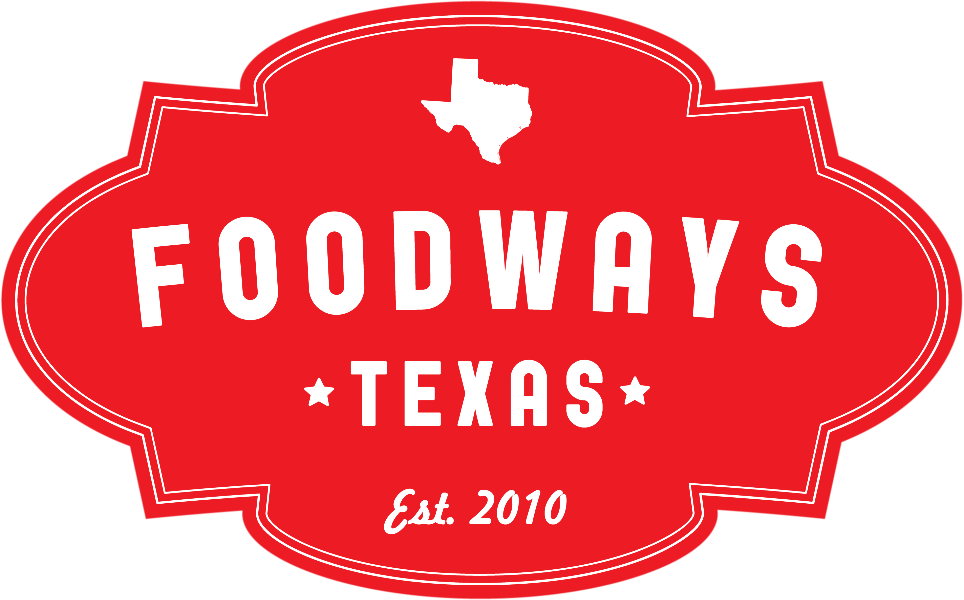Interviewer: Eric Covey and Carly Kocurek
Location: Southside Market, Elgin, TX
This interview was originally produced through a collaborative effort of the American Studies Department at the University of Texas at Austin, The Central Texas Barbecue Association, and The Southern Foodways Alliance.
Fieldwork coordinator: Dr. Elizabeth Engelhardt; Project consultant: Amy Evans
It is shared with Foodways Texas as part of an ongoing collaboration with the Southern Foodways Alliance to document food history and culture in Texas.
Ernest, Sr. (1930-2012) and Adrene Bracewell purchased Southside Market from Jerry and Edwin Stach in September of 1968. Known for years as a meat market that served a mean barbecue sausage, Southside Market added barbecue brisket to the menu in the 1970s.
Ernest, Sr. and Adrene’s son Ernest Bracewell, Jr. (known as Billy) has been Vice President of Southside Market since 1968. Billy's son Bryan has worked in the family business since he was twelve, taking a break to attend Texas A&M University, where he studied meat science, from 1994 until 1998.
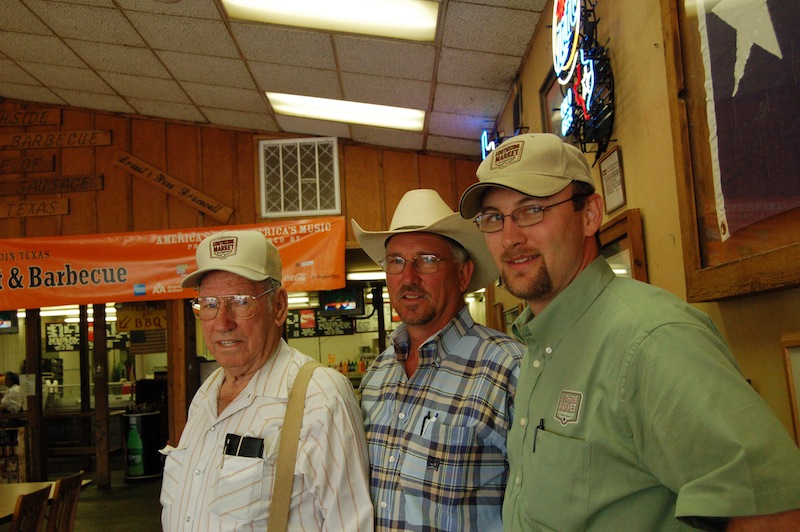















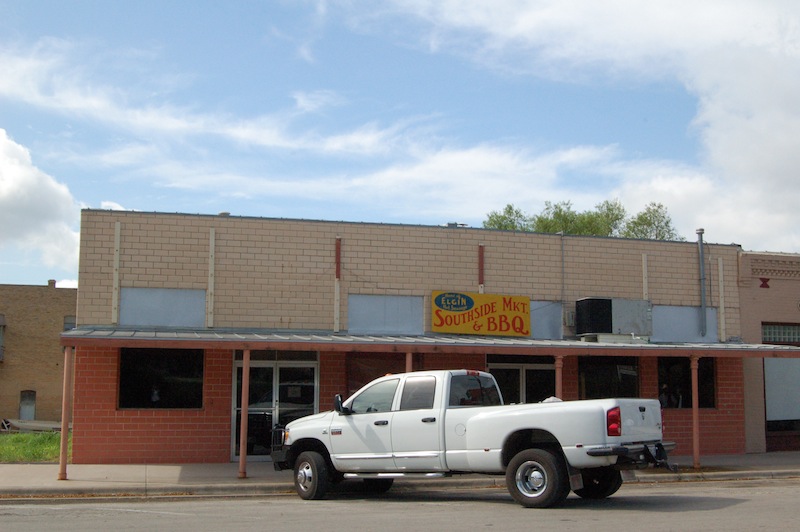
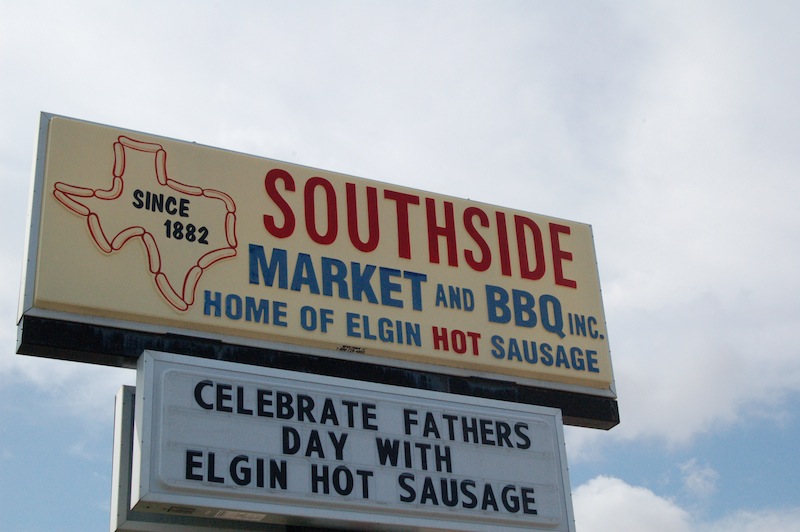
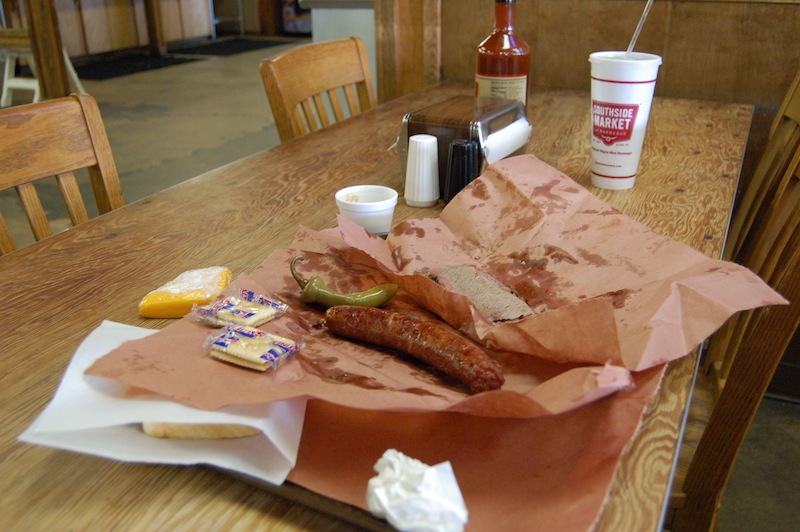

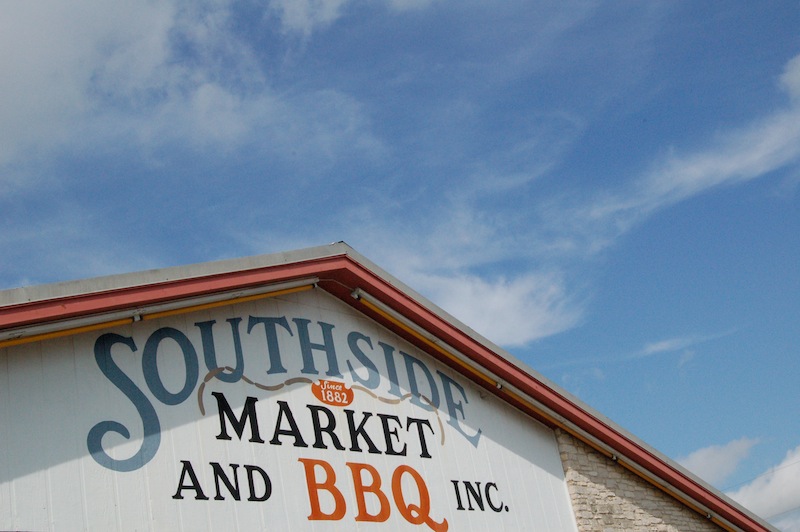
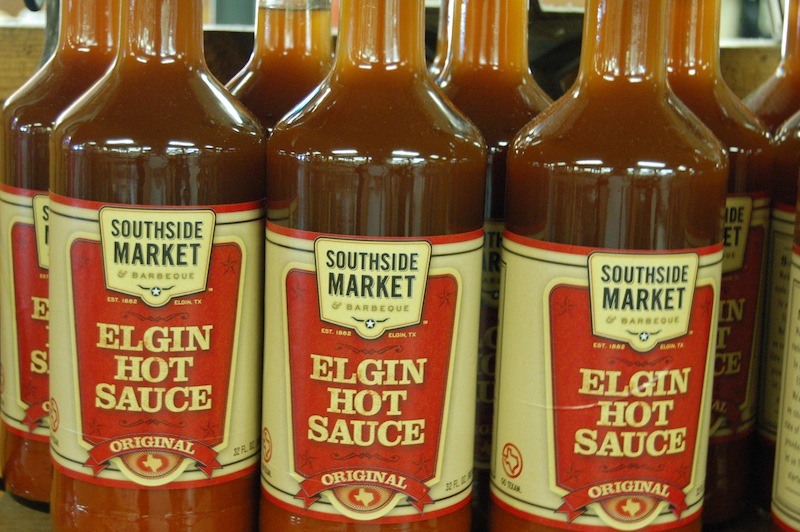
Eric Covey: All right, we’re recording. This is Eric Covey. It’s the eighteenth of June, 2007. It’s about 8:30 in the morning out here at Southside Market in Elgin, Texas—talking to Ernest, Billy, and Bryan Bracewell. If you folks could for me, could you just go ahead and say your names and birthdays?
Ernest Bracewell: Ernest Bracewell, two, eight, thirty.
Billy Bracewell: Billy Bracewell September 23, 1955.
Bryan Bracewell: Bryan Bracewell September 6, 1975.
OK. Let’s go ahead and maybe start with kind of a—uh—a big question here that I hope you can kind of fan off of. Can you tell me about the history of Southside Market?
Ernest: Well this, I can go from 1968, but I can tell you what I had been told back many years before because we had a fellow working for me. His name was Bud Frazier and he was in from about the start of Southside Market. And when it started out, they butchered cattle and they brought the meat and stuff into town on wagons and delivered to the homes because they didn’t have refrigeration, so. It was a butcher today, deliver today. And that was the real start of Southside Market. And then, on through the years, they added sausage and meat counters, when it, you know, and it just kept growing since then. And there’s been a lot of changes in Southside since the start of it.
OK. What are some of the changes?
Ernest: Well they got refrigeration, you know, and everything modern, you know, to bring up the meat so it will stay fresh and you keep it longer. And—uh—people come in and by it—were used to, it was very slow. This was a country town, a farming town, and most of the people wouldn’t come to town except on Fridays and Saturdays. That’s when the meat market really had to—to get together and sell their meat. And anything like that leftover, it was, you know, sometimes they sell it and sometimes they didn’t. But then they started sausage. And that started out like on Fridays and Saturdays when the farmers come in, and—uh—that was something to eat besides going to the other cafes. And—uh—it started there and it’s been going ever since.
Bryan: Who were the first typical customers? Farmers and Ranchers?
Ernest: Farmers and Ranchers around here.
Bryan: What was it that they farmed?
Ernest: Cotton. The main thing was cotton back then. And they had lots of field help. A lot of these farmers around here had eight—six, eight, ten houses, shacks really where the workers would come in, work their crops, and have a place to stay. It wasn’t luxury, but there wasn’t no luxury back then. So, that’s really what got the market started.
***
OK. And how many people have owned Southside over the years?
Ernest: Really—uh—four. Let’s see, you had Moons, and then you had Wilson, and then you had the Stach brothers, and then you had the Stach with the—who was it?—Zimmerhanzels, Charlie and Monroe Stabeno, and then I bought it from the Staches in 1968 and owned it ever since.
OK. Why do—what made you decide to own a barbecue restaurant?
Ernest: Well, I was working for Armor and Company. And I was calling on this place. And they kept asking me, “Did you want to—Do you want to buy this? Do you want to buy this?” They were trying to sell it to me. And in the mean time, Armor and Company was shutting down a lot of their territory, their salesmen, and everything, and they were just getting thinner and thinner. And I figured, well Ernest, this is your time to either get out and get on the bandwagon or go find something else to do. So, I found a lender, and got me some money together, and I bought it. I’ve been here ever sense.
Were you from Elgin originally?
Ernest: No. I’m originally born in Stockdale, Texas. But I moved from San Antonio to Austin, and I was still calling on this place. And then, when I got the money, I just moved from Austin to Elgin, which is where I am still today.
And when you purchased Southside in 1968? Was it—was this the building it was in then?
Ernest: No, no. It was downtown Elgin, 109 Central. And over the years, it moved downtown to three different buildings. The last move was 109, 107 Central. That’s when the Staches bought it, and they put in, you know, better coolers, and counters. And back—in the back end where you could eat, at first it was dirt floors. Back in the barbecue area it wasn’t—then they put concrete in there. And so, they just kept going. And then in—years later I put—added another dining room to it so I could—we could serve more customers. And then we had a fire. And then we rebuilt and moved from downtown to out here on highway in 1992. And we were here ever since.
OK. Other than the location, what else has changed in the business over the years?
Bryan: Well, the business started as, you know, a small town butcher shop. And the barbecue was just a derivative of having fresh meat on hand, you know, back before the days of refrigeration. In 1882, when William Moon started butchering animals and bringing them to town, they had a short window of time where they either had to get it sold, get it in somebody’s tummy, or—uh—preserve it in some way. And so they only ways to preserve it back then were either salting it or—uh—cooking it. And so, the barbecue restaurant is just a—really a derivative of having fresh meat on hand. Uh, so, from ’82 until ’86, the business was operating like that with barbecue, sausage, and everything on the weekends. And then in ’86, William Moon started the first, I guess, storefront Southside Market in—on Central Street in downtown Elgin. And—uh—he owned that location for that business until 1908 when Lee Wilson purchased it. That’s about the time that I think Bud Frazier started working, somewhere in there, who worked with Southside until the early ‘70s, I guess. He had worked for Southside his entire life. From 1908 until 1942, which was Lee Wilson’s time period—uh—Bud Frazier owned it—owned the business several times during that, but it always had reverted back to—uh—Lee Wilson. And—uh—correct me if I’m wrong, but Bud Frazier had told y’all that several times he would come to work on a Thursday morning and the business had changed hands in a Wednesday night card games. Is that right?
Ernest: Yes, that’s true. That’s what he told me. He’d come to work on Thursday, and sometime who’s the boss, you know. It’d be a different one. And next week, it might be a different one. But usually Lee Wilson would win it back, someway or another, I don’t know, but it was lost several times in the poker games. And the poker house that they played in was out there just about three quarters of a mile from where we butcher. So, it was out in the middle of nowhere, you know. And they—they always had the big card games. It was win, lose, or draw. And so, that’s the way it went then.
Bryan: So from—during the Lee Wilson era, the business kind of had a colorful past. And Bud Frazier worked through all that, but Lee Wilson ultimately maintained control of the business and in 1942 he sold the business to Jerry Stach, Monroe Stabeno, and Charlie and Van Zimmerhanzel, who were brothers. They bought it from Lee Wilson in ’42 and they—uh—built a new slaughter plant at the site of the original slaughter plant, which is still standing today, just mainly a slab. We built a barn on top of the original slab from 1882. But in ’42 they built a larger slaughter plant, and kind of expanded the operation on FM 1704, which is about a mile to a mile and a half from the Central Street location, where the retail business was at. So, those partners owned the business until ’48, and—uh—Jerry Stach bought out his other partners and then brought on his brother, Edwin Stach, to join him. And the two Stach brothers ran the business until ’68. And then in 1968, what was it, September 1?
Ernest: Yep. That’s correct.
Bryan: September 1 is when—uh—my grandma and grandpa bought the business and moved the family down to Elgin. That was, I guess, my dad’s first—uh—first day to work in the business as well. He was right at twelve years old, which coincidentally was the same age that I was when I started working in the business. And in the early days, when you bought it, what were the main menu items? Or the—first of all the restaurant was the small part of the business and the butcher shop was—
Ernest: Yes. That’s right. The main menu for the barbecue was sausage—sausage, sausage, sausage. We had a little beef—had beef steaks and pork steaks and a few things like that, but the main thing was sausage. It has always been sausage, it still is sausage today. It’s the main item. So—
Bryan: So mainly the—the small town butcher shop. And y’all slaughtered—uh—pigs and calves out the slaughter plant and brought them up into town to Central Street. And—uh—were just the small town butcher shop really servicing the Elgin community.
Ernest: We just served the community around here—all people that had cattle and wanted it to be butchered and put it in their own home freezer. We would butcher them, cut them up, wrap them, freeze them, and they could take it home. And that’s the way it went for a good while. And then it got to the point where fewer people were butchering and putting it in their freezer. They’d rather go to the store and buy it and cook it day to day than—in fact, the cooking methods changed so that the ladies don’t have time to go home and thaw out a bunch of meat and then cook it because they’re working. And so, they like to have it ready to go.
Bryan: So, in the beginning, most of the slaughtering that y’all did was on custom basis. Farmer and ranchers would bring their animals in and then y’all slaughtered it for them. And then you also slaughtered Southside’s own animals for the—for the meat case. So, from the roots of being a small town butcher shop, over time, it derived it to where the barbecue restaurant took over. I think it was—wasn’t it the early ‘70s when y’all added brisket to the menu?
Ernest: Yes. We added brisket to the menu and just—you know every time—and pork ribs and items like that. So, people had a variety of—just besides sausage. They could have other meat to if they wanted. And that’s where we changed the whole concept of Southside Market. It’s regular barbecue, and they can choose, like I say, just not just one item like it used to be, but many more items to eat.
Bryan: Now when you bought the business in ’68 there was a dividing wall down the center of the restaurant. Isn’t that right?
Ernest: Yes. That’s true.
Bryan: It was for—it was during the—when everything was segregated. Basically blacks were on one side and whites were on the other.
Ernest: Correct.
Bryan: And that—that was still that way in ’68 when you bought it?
Ernest: The wall was still there, but—uh—they could eat on either side they wanted to in ’68. It wasn’t designated as one side or the other, but—uh—it was there. The wall was there until we had the fire in ’83.
***
That’s interesting. OK. I have a question. Actually, I have three generations here obviously, so how—how did it turn out that all three of you ended up involved with the barbecue restaurant.
Ernest: Well, I bought if for a living, you know, to make a living. And so, I—like I said, I thought my job with the Armor and Company was going to play out, which I’m sure it would have in another six months of a year because they closed it down. And so, I just went to work and think, well I’ll work for myself. And then—
Billy: I basically grew up, and—um—that’s all I’ve ever known—had an apron put on me at twelve years old and been doing it ever since. That’s basically how I got into it.
Bryan: For me, it was like my dad growing up in it. And I remember eating at the old restaurant prior to the fire in ’83, and I was born in ’75. So I was pretty young, I mean, it was just part of the way of our life. You know—uh—the uh—we call it The Market. My dad worked in The Market; my mom worked in The Market off and on, when she wasn’t keeping us. And so, it was just part of a way of life. I grew up never having to decide or think what I was going to do in life, just knew that I was going to be here. I took a break for four years, went to Texas A&M, studied food science—meat science—and then came back a hung around a little bit too long and they put me to work, but I don’t ever remember making a conscious decision to work here or not to work here. It just kind of happened.
